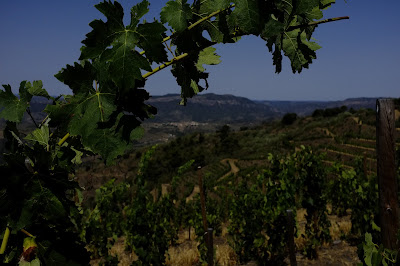Spain may be a country facing all number of economic problems, but boy does it have some serious winemaking talent. Our most recent trip, a whirlwind tour that involved many hours behind the wheel, took us from Ossian's sandy, pre-phylloxera vineyards in Rueda, up to the wild west of Ribera del Duero, up and futher across to San Vicente in Rioja and then finally all the way east to Catalonia and the hot, dry hills of Priorat.
En route we encountered breathtaking countryside, big skies and huge vistas, soaring buzzards, warm people, old vines and low yields, plenty of delicious ham and even more delicious wine. In what feels like Hemmingway country there are wines being made that offer such pure, ripe, complex, silky seduction it is amazing they are not more highly sought after over here in the UK market.
 |
| Arid soils in Ribera del Duero |
Three major factors crop up again and again. Old vines, warm, dry, sunny and most importantly disease inhibiting weather, and experimentation. At not a single one of the domaines that we visitied were we not shown something new; a technique, a decision, a new bottling, amphorae, a new training method, straw between the vines to keep the soil cool. Perhaps because the new wave of Spanish winemaking is a relatively recent phenomenon, there is a buzz and a can do/will do attitude to be found that is both infectious and exciting.
In Ribera and Rioja the 2009 vintage has produced silky sumptuous wines that have luscious textures but no lack of freshness. It is a highly successful vintage. Tasting the wines from Aalto, in their wonderfully modern, architectural Bodega, it was hard not to think that this vintage will see them propelled to even greater popularity. Most definitely one to buy En Primeur.
Over in Rioja the Eguren family continue to rule the roost. Held in the highest regard in Spain, yet still relatively unknown over here, they receive about as much critical acclaim as any of our growers. And for good reason. Traditional plantings, often seriously old, even pre-phylloxera, combined with a modernist outlook in the winery gives wonderful results. And as if there Rioja holdings weren't impressive enough, Marcus Eguren continues to rachet up quality levels at their Toro Estate Teso La Monja. Elegance and power combined - this is Tinto de Toro at its most exquisite.
 |
| The view from Mas Martinet's Escurcons vineyard. The highest in the region |
The hills of Priorat, with their twisty roads and infuriating signage, provide the setting for what must be one of the most dramatic wine regions in the world. Grenache and old Carignan plantings dominate, coming to their absolute best on the crumbly slate "licorella" soils. You see a cross section, with less than a foot of soil before slate begins and you honestly wonder at the vines ability to carve out a life for itself here. This is extreme viticulture, hot and dry, and the results are utterly thrilling. It is also, in it's newest guise, a region of relatively little age, the new wave only beginning in the 1980s, dragging the region out of a period of low economic prosperity. Mas Martinet, Vall Llach and Mas Doix each manipulate a different part of the region. And they all manage to achieve different expressions. In 2009, again hot and dry, there is a certain power to all these priorat wines. Power and intensity. But the greatest benefit the Licorella brings is a mineral spice and freshness to carry that power. This slate, and the clean firm backbone it lends to the wines, really is the essence of Priorat.
 |
| Licorella slate heavy soils in Priorat |
Excessive talk of the high alcohol content of these wines is to miss the point of their being rooted to and very much of these wild arid hills. A wine harvested prematurely at 13% potential that has not had the chance to fully ripen will never give much pleasure. These great priorats, harvested fully ripe at a degree or two more than that might be alcoholic, but they are also balanced, and profound, and unforgettable.


